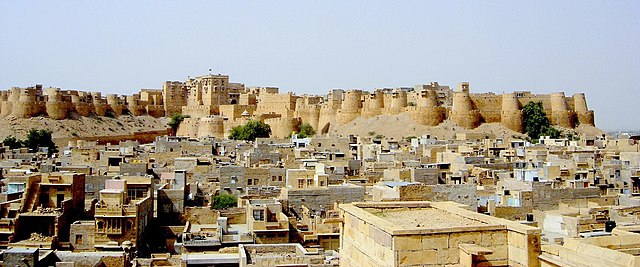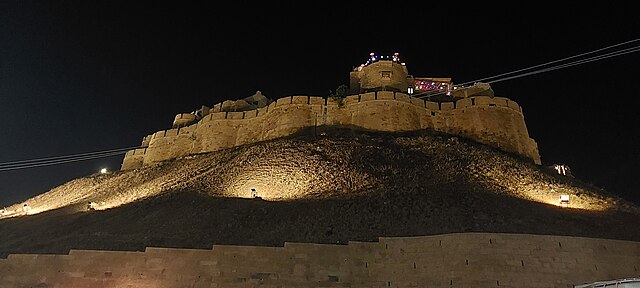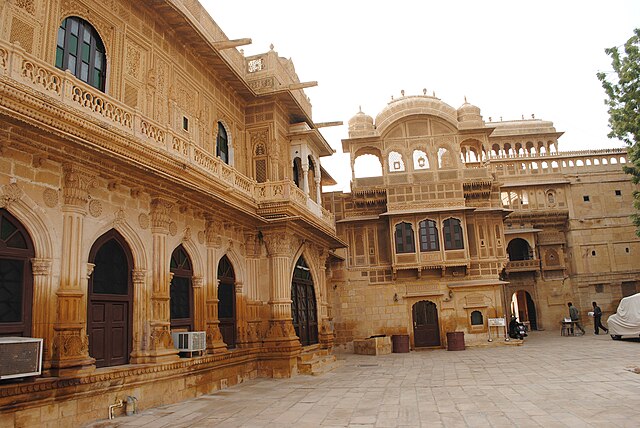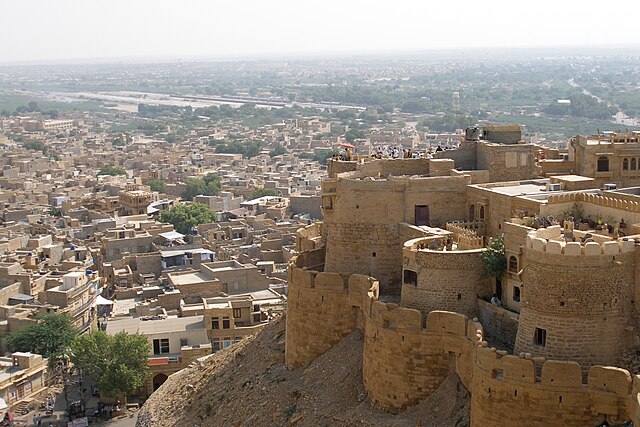Imagine a city that seems to rise like a mirage from the heart of the Thar Desert, its golden sandstone glowing under the relentless sun. That’s Jaisalmer, Rajasthan’s Golden City, a place where history, culture, and adventure collide in the most spectacular way. From the towering Jaisalmer Fort, a living UNESCO World Heritage Site, to the sweeping dunes of Sam, this city feels like a page ripped from an ancient fairy tale. Whether you’re chasing history, craving desert thrills, or just want to lose yourself in vibrant Rajasthani culture, Jaisalmer’s got you covered. Ready to explore this golden wonder? Let’s dive in!
Why Jaisalmer Captivates Every Traveler
Jaisalmer isn’t just a destination; it’s an experience that grabs you by the senses and doesn’t let go. Picture walking through streets where every building shimmers like gold, or camping under a sky so full of stars it feels like the universe is putting on a show just for you. The city blends medieval charm with modern adventures, offering something for everyone—history buffs, thrill-seekers, and culture lovers alike. It’s the kind of place where you can wander through a 900-year-old fort in the morning and ride a camel across the dunes by sunset. Sound like your kind of vibe? Let’s see why Jaisalmer deserves a spot on your travel list.
A Journey Through Jaisalmer’s Rich Past
Jaisalmer’s story is as old as the desert itself. Founded in 1156 CE by Rawal Jaisal, a Bhati Rajput king, the city was a key stop on the Silk Route, linking India to Central Asia. Traders from distant lands passed through, swapping goods, ideas, and stories, which shaped Jaisalmer into a cultural melting pot. Its location in the Thar Desert made it a fortress of resilience, with the Bhati Rajputs defending it against invaders while fostering trade. Today, the city’s golden sandstone architecture and ancient traditions keep its history alive, inviting you to step into a world where the past feels closer than ever.
The Bhati Rajputs: Desert Royalty
The Bhati Rajputs are the soul of Jaisalmer’s story. These fierce warriors didn’t just build a city; they crafted a legacy that still shines through its forts and havelis. Think of them as the desert’s architects, blending strength with artistry to create a kingdom that could withstand time and sandstorms. Their influence is everywhere—from the intricate carvings in the fort to the proud spirit of the locals. Walking through Jaisalmer, you can almost hear the echoes of their valor, whispering through the golden streets.
Jaisalmer Fort: A Living Legend

Ever visited a fort that’s still buzzing with life? Jaisalmer Fort, or Sonar Quila, is exactly that—a golden fortress where people live, work, and pray, just as they did centuries ago. Built in 1156, this UNESCO World Heritage Site rises from the desert like a giant sandcastle, its sandstone walls glowing under the sun. Inside, narrow lanes twist past temples, shops, and homes, creating a maze of history and hustle. It’s not just a monument; it’s a living, breathing piece of Jaisalmer’s heart. Ready to explore its secrets?
Inside the Golden Fort: Must-See Spots
Stepping into Jaisalmer Fort is like walking into a time machine. The Raj Mahal, once the royal palace, dazzles with its mirrored rooms and carved arches. Then there are the seven Jain temples, their intricate stonework so delicate it feels like lace frozen in time. Don’t miss the four massive gateways—each one a masterpiece of Rajput design. Climb to the ramparts for a view that stretches across the golden city and the desert beyond. It’s the kind of sight that makes you pause and wonder: how did they build this in the middle of nowhere?
Jain Temples: Art and Spirituality
Tucked inside Jaisalmer Fort, the Jain temples are a hidden treasure. Built between the 12th and 15th centuries, these seven temples are dedicated to Jain Tirthankaras and adorned with carvings so intricate they could rival a jeweler’s work. Picture pillars etched with mythical creatures and ceilings that seem to dance with stories. These temples aren’t just places of worship; they’re a testament to Jaisalmer’s pluralistic past, where Jainism flourished alongside Rajput culture. Visiting them feels like stepping into a sacred art gallery.
Havelis: Jaisalmer’s Architectural Jewels
If the fort is Jaisalmer’s heart, its havelis are its crown jewels. These ornate mansions, built by wealthy merchants in the 19th century, are like love letters carved in stone. Patwon Ki Haveli, Nathmal Ki Haveli, and Salim Singh Ki Haveli steal the show with their jaw-dropping facades and intricate interiors. Each one tells a story of prosperity, artistry, and ambition. Walking through them is like flipping through a history book where every page is a work of art. Ready to meet these architectural superstars?
Patwon Ki Haveli: A Masterpiece in Stone
Patwon Ki Haveli is the rockstar of Jaisalmer’s havelis. This cluster of five mansions, built by the Patwa family, is a feast for the eyes with its golden facade and lattice-like carvings. Inside, you’ll find painted walls, mirrored ceilings, and courtyards that feel like a royal dream. It’s no wonder photographers go wild here. Built to showcase wealth, this haveli is a reminder of Jaisalmer’s days as a trading powerhouse. Ever wondered what it’s like to live in a palace? This is your chance to find out.
Nathmal Ki Haveli: A Symphony of Symmetry
Nathmal Ki Haveli is the artist of the haveli trio. Built by two brothers, its facade is a perfect blend of symmetry and creativity, with carvings so detailed they look like they were painted by the desert wind. Legend has it the brothers worked on opposite sides, creating slight differences that add to its charm. Inside, vibrant frescoes and arched ceilings tell stories of the merchants who once lived here. It’s the kind of place that makes you wonder: how did they make stone look so alive?
The Thar Desert: Adventure Awaits

The Thar Desert is Jaisalmer’s wild side, a golden playground where adventure meets serenity. Imagine endless dunes stretching under a blazing sky, waiting for you to explore. From camel safaris to jeep rides, the desert offers thrills that get your heart racing. At night, it transforms into a magical stage for starlit camps and Rajasthani music. It’s like the desert is inviting you to play, dream, and lose yourself in its vastness. Ready to answer its call?
Sam Sand Dunes: Where the Desert Sings
About 40 kilometers from Jaisalmer, the Sam Sand Dunes are where the desert comes alive. Picture yourself swaying on a camel as the sun sets, painting the sky in shades of fire and gold. Or maybe you’re speeding through the dunes in a jeep, the wind in your hair and adrenaline in your veins. By night, desert camps offer bonfires, folk dances, and a sky so clear it feels like you’re staring into infinity. It’s the kind of experience that makes you feel like you’re part of something bigger.
Desert Camping: A Night of Magic
Desert camping in Jaisalmer is like hitting pause on the chaos of the world. You’re surrounded by nothing but sand and silence, yet it feels like the universe is whispering to you. Luxury tents come with modern comforts, so you’re not exactly roughing it. Picture enjoying a Rajasthani thali under the stars, swaying to folk tunes, and falling asleep to the desert’s quiet magic. It’s a bucket-list experience that blends adventure with peace, leaving you with memories you’ll carry forever.
Cultural Vibes: Jaisalmer’s Heartbeat
Jaisalmer’s culture is as vibrant as its golden sands. From lively festivals to soulful music, the city pulses with Rajasthani spirit. The locals, with their colorful turbans and warm smiles, make you feel like you’re part of the story. Whether it’s dancing at a festival or savoring a spicy desert dish, Jaisalmer’s traditions pull you in and make you want to stay. Can you feel the rhythm of the desert yet?
Desert Festival: A Riot of Color
Every February, Jaisalmer throws a party that’s pure magic—the Desert Festival. Held at the Sam Sand Dunes, this three-day extravaganza is a celebration of Rajasthani culture. Think camel races, turban-tying contests, and folk dancers spinning in vibrant skirts under the desert sun. The festival is a whirlwind of color, music, and joy, drawing travelers from across the globe. Ever seen a man with a mustache long enough to win a contest? You will here!
Rajasthani Food: Flavors of the Desert
Jaisalmer’s cuisine is a love letter to the desert. Dishes like dal baati churma—a hearty mix of lentil curry, baked wheat balls, and sweet crumbled goodness—warm your soul. Or try ker sangri, a tangy dish made from desert beans and berries that’s as unique as the Thar itself. Local eateries serve thalis piled high with these treats, often paired with a glass of creamy lassi. It’s not just food; it’s a taste of Jaisalmer’s rugged, vibrant heart.
Gadisar Lake: A Desert Oasis

In the middle of the Thar Desert, Gadisar Lake feels like a gift from the gods. Built in the 14th century, this man-made reservoir is surrounded by temples and chhatris, creating a serene vibe that’s pure magic. Take a boat ride at sunset, and you’ll feel like you’re floating through a painting. The lake also attracts migratory birds, making it a haven for birdwatchers. It’s the perfect spot to catch your breath after a day of exploring Jaisalmer’s bustling streets.
Shopping in Jaisalmer: Desert Treasures
Jaisalmer’s bazaars are a treasure hunter’s dream. Sadar Bazaar and Pansari Bazaar buzz with stalls selling everything from camel leather bags to mirrorwork embroidery. You’ll find vibrant textiles, silver jewelry, and handcrafted souvenirs that capture the desert’s spirit. Haggling is part of the fun, so channel your inner bargainer! Want a keepsake that screams Jaisalmer? Grab a piece of mirrorwork—it’s like carrying a piece of the desert’s sparkle home.
Planning Your Jaisalmer Escape
Ready to pack your bags for Jaisalmer? The best time to visit is October to March, when the desert’s heat takes a break. The city is well-connected by road and rail, with Jodhpur’s airport (about 300 kilometers away) being the closest. Budget travelers can crash in cozy guesthouses, while luxury seekers can opt for heritage hotels or desert camps. Pack sunscreen, comfy shoes, and a sense of adventure—Jaisalmer will handle the rest.
Pro Tips for an Unforgettable Trip
To make your Jaisalmer trip epic, plan smart. Book desert camps early, especially during the Desert Festival season. Carry cash for small vendors, as digital payments can be spotty. Hire a local guide—they’re like storytellers who bring the city’s history to life. And don’t miss a sunrise or sunset over the dunes; it’s like the desert’s way of saying, “You’re welcome.” Trust me, these moments will stay with you long after you leave.
Conclusion
Jaisalmer is more than a city—it’s a golden dream woven from sand, stone, and stories. From the living Jaisalmer Fort to the endless dunes of the Thar, every corner of this desert gem sparkles with history, culture, and adventure. Whether you’re marveling at havelis, savoring Rajasthani flavors, or camping under a starlit sky, Jaisalmer wraps you in its magic and leaves you wanting more. So, what’s stopping you? Grab your bags, chase the golden mirage, and let Jaisalmer steal your heart!
FAQs
1. When is the best time to visit Jaisalmer?
October to March is ideal, with cooler temperatures perfect for exploring the city and desert.
2. How do I reach Jaisalmer?
Jaisalmer is accessible by road and rail from cities like Jodhpur and Jaipur. The nearest airport is in Jodhpur, about a 5-hour drive away.
3. Is Jaisalmer safe for solo female travelers?
Yes, Jaisalmer is generally safe, with welcoming locals and tourist-friendly infrastructure. Just follow standard travel precautions.
4. What should I pack for a Jaisalmer desert camp?
Pack light clothing, a hat, sunglasses, sunscreen, and a warm layer for chilly desert nights. Comfortable shoes are key for dune adventures.
5. What’s unique about Jaisalmer’s Desert Festival?
The Desert Festival, held in February, features camel races, folk performances, and turban-tying contests, showcasing Rajasthan’s vibrant culture.

